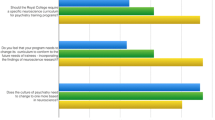Abstract
Objective
Incorporating new neuroscience findings relevant to psychiatry into the medical school curriculum is challenging, especially at the level of clinical learning. In this pilot project, third-year medical student volunteers in their required 8-week clerkship participated in an e-mail-based experience relating contemporary neuroscience to psychiatry.
Methods
A faculty preceptor guided participants using one of the participants’ patient work-ups as a platform to explore questions related to the neurosciences. Participants were surveyed for follow up.
Results
Eleven of 13 eligible students agreed to participate in the study during one academic year. Data is qualitative, consisting of the responses of the students and the formulations and feedback of the preceptor as the project proceeded.
Conclusion
Participants were successful in identifying symptom complexes in the sample history and in exploring their questions in the literature and with one another. The protocol is well-suited to distance learning, is relevant to psychiatric education, and is flexible in its application.
Similar content being viewed by others
References
Grunze H, Strupp M, Ronnebert T, et al: Problem-based learning in medical education: integrated “nervous system and behavior” course at the Munich Ludwig Maximilian University. Der Nervenarzt 2004; 75(1): 67–70
Giffin BF, Drake RL: Gross anatomy of the head and neck and neuroscience in an integrated first-year medical school curriculum. Anat Rec 2000; 261(2): 89–93
Mohl PC: Model curricula: an introduction. Acad. Psychiatry 2001; 25: 87–89
Hyman SE and Fenton WS: What are the right targets for psychopharmacology? Science 2003; 299: 350–351
IRB#:C03-006, Michigan State University
Jenike MA: The “geriatric difference”: depression Dx, office workup, preoperative assessment.” Geriatrics 1986; 41: 26
Linehan MM: Dialectical Behavioral Therapy of Borderline Personality Disorder. New York: Guilford, 1993
Bransford JD, Brown AL, Cocking RR (eds): How People Learn: Brain, Mind, Experience and School, National Academy Press, Washington DC, 2000
Ibid, pp. 134–135
Ibid, pp. 137–138
Glaser R, Baxter GP: Assessing Active Knowledge, CSE Tech. Rep. number 516, Center for the Study of Evaluation, National Center for Research on Evaluation, Standards, and Student Testing, UCLA, http://cresst96.cse.ucla.edu/products/reports_set.htm
Wolfson L, Willinsky J: Situated learning in high school information technology management. J Res Comp Educ 1998; 31(1): 96–110
Cheesman R: Moving the Roskilde model into cyberspace: problem-based learning in groups in a net environment, paper presented at the 7th Conference of Baltic University Rectors, Roskilde University, Denmark, 16–18 June 1999, http://akira.ruc.ak/~robin//pubs/CBUR99.pdf
Abell ML, Galinsky MJ: Introducing Students to Computer-Based Group Work Practice. J Soc Work Educ 2002; 38(1): 39–54
Gilliver RS, Randall B, Pok YM: Learning in cyberspace: shaping the future. J Comp Assist Learn 1998; 14: 212–222
Roberts J: Learning to learn—over the Internet. Can cyberspace assist education in the health domain? Br J Healthcare Comput Info Manage 1999; 16(9): 32–34
Rubin EH, Zorumski CF: Psychiatric Education in an Era of Rapidly Occurring Scientific Advances. Acad Med 2003; 78: 351–354
Taylor MA, Vaidya NA: Psychopatholgy in neuropsychiatry: DSM and beyond. J Neuropsychiatry Clin Neurosci 2005; 17(2): 246–249
Bransford JD, Brown AL, Cocking RR: OP.CIT. pp 31, 45–17
Byrnes JP: Cognitive Development and Learning in Instructional Contexts, 2nd ed, Boston, Allyn & Bacon, 2001
Author information
Authors and Affiliations
Corresponding author
Additional information
This study was presented in a workshop at the annual meeting of the Association for Directors of Medical Student Education in Psychiatry, Montreal, Quebec, June, 2004.
The author thanks the students who participated in this study the faculty of the Michigan State University College of Human Medicine Department of Psychiatry for their support and encouragement, and Michael Liepman for his editorial assistance.
Rights and permissions
About this article
Cite this article
Dunstone, D.C. A Neurosciences-in-Psychiatry Curriculum Project for Medical Students. Acad Psychiatry 30, 166–169 (2006). https://doi.org/10.1176/appi.ap.30.2.166
Received:
Revised:
Accepted:
Published:
Issue Date:
DOI: https://doi.org/10.1176/appi.ap.30.2.166




